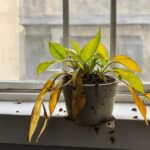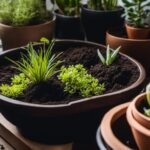How to Grow and Care Aloe Vera Plants Indoors and Outdoors, type, common problem, pest and disease issue, prune, light, water, soil, temperature, fertilizer, propagation (2024Guide)
Growing and caring for aloe vera plants is a wonderful way to bring natural beauty and health benefits into your home or garden. Whether you prefer to cultivate them indoors or outdoors, these versatile plants can thrive with the right care and conditions. In this guide, I will share with you essential tips and techniques for successfully growing and caring for your aloe vera plants, both indoors and outdoors.
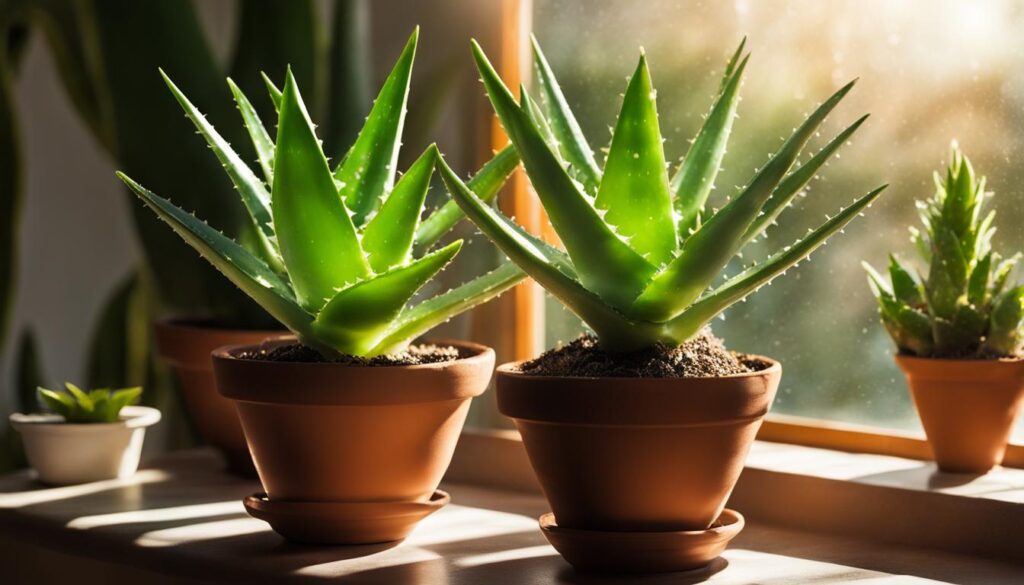
Before we dive into the specifics, let’s take a moment to appreciate the incredible diversity within the Aloe genus. From the popular Aloe Vera to the enchanting Aloe Polyphylla, each type of aloe plant has its own unique charm and care requirements. By understanding the characteristics and needs of your chosen aloe vera variety, you can ensure its thriving growth and maximum benefits.
Key Takeaways How to Grow and Care Aloe Vera Plants Indoors and Outdoors:
- Choose the right type of aloe vera plant for your specific needs and growing conditions.
- Proper watering, sunlight, and soil conditions are crucial for the health of your aloe vera plants.
- Aloe vera plants can be grown both indoors and outdoors, depending on your climate and preference.
- Regular pruning, repotting, and proper harvesting techniques are essential for the care of your aloe vera plants.
- Monitoring and addressing common issues promptly can help maintain the overall health of your aloe vera plants.
Types of Aloe Plants
Aloe plants come in a wide variety of types, each with its own unique characteristics and care requirements. Here are some popular types of aloe plants:
- Aloe Vera: The most well-known type of aloe plant, Aloe Vera has thick, fleshy leaves and is known for its healing properties.
- Aloe Arborescens: This type of aloe plant is a tree aloe, growing tall with long, arching leaves and bright orange flowers.
- Aloe Aristata: Also known as the Torch Plant, Aloe Aristata has thick, triangular leaves with white spots and produces beautiful coral-colored flowers.
- Aloe Polyphylla: Commonly referred to as the Spiral Aloe, this type of aloe plant forms a stunning rosette shape with spiral leaf arrangements.
- Aloe Ferox: With tall flower spikes and spiky leaves, Aloe Ferox is a striking aloe plant that is native to South Africa.
- Aloe Variegata: Often called the Partridge-Breasted Aloe, this aloe plant features unique white variegation on its leaves.
- Aloe Mitriformis: The Lace Aloe, as it is commonly known, has delicate, lace-like patterns on its leaves and produces vibrant orange flowers.
Each of these aloe plant types offers its own visual appeal and can be a great addition to your indoor or outdoor garden. When choosing an aloe plant, consider the specific care requirements and growth habits of each type to ensure it thrives in your desired environment.
| Type of Aloe Plant | Characteristics | Care Requirements |
|---|---|---|
| Aloe Vera | Thick, fleshy leaves with healing properties | Bright, indirect sunlight Well-drained soil Occasional deep watering |
| Aloe Arborescens | Tall, arching leaves Bright orange flowers | Full sun Well-drained soil Minimal watering |
| Aloe Aristata | Triangular leaves with white spots Coral-colored flowers | Bright, indirect sunlight Well-drained soil Minimal watering |
| Aloe Polyphylla | Spiral leaf arrangement Stunning rosette shape | Partial shade Well-drained soil Infrequent watering |
| Aloe Ferox | Spiky leaves Tall flower spikes | Full sun Well-drained soil Minimal watering |
| Aloe Variegata | White variegation on leaves | Bright, indirect sunlight Well-drained soil Occasional deep watering |
| Aloe Mitriformis | Lace-like patterns on leaves Vibrant orange flowers | Partial shade Well-drained soil Infrequent watering |
How to Grow Aloe Vera Indoors
Growing aloe vera indoors is a great way to enjoy the benefits of this versatile plant all year round. To successfully grow aloe vera indoors, it’s important to provide the plant with the right conditions for optimal growth. Here are some key steps to follow:
Choosing the Right Pot and Soil
Start by selecting a terracotta pot that has drainage holes to prevent water from pooling at the bottom. This will help avoid overwatering, which can lead to root rot. Use a well-drained potting mix specially formulated for succulents plants or create a mix of sand and potting soil.
Placement and Lighting
Place your aloe vera pot in a bright, sunny spot where it can receive indirect sunlight. Aloe vera plants thrive in bright light, but direct sunlight can scorch their leaves. If you notice the leaves turning brown or yellow, it may be a sign that the plant is receiving too much sun.
Watering and Maintenance
Water your aloe vera deeply but infrequently. Allow the soil to dry out completely between waterings to prevent overwatering. A good rule of thumb is to water the plant about once every two weeks, but this may vary depending on the temperature and humidity levels in your home. Remember, it’s better to underwater than overwater your aloe vera plant.
Overall, growing aloe vera indoors is a rewarding and relatively low-maintenance experience. With the right care and attention, your indoor aloe vera plants can thrive and provide you with their numerous benefits.
Key Steps for Growing Aloe Vera Indoors
- Choose the right type of pot like a terracotta pot with drainage holes
- Use well-drained potting mix or a mix of sand and potting soil
- Place the pot in a bright spot with indirect sunlight
- Water deeply but infrequently, allowing the soil to dry out completely
By following these steps, you can successfully grow aloe vera plants indoors and enjoy their beauty and benefits in your home.
How to Grow Aloe Vera Outdoors
Growing aloe vera outdoors can be a great option if you live in a warm climate (Zone 10 or higher). These resilient plants can thrive in a variety of conditions but require proper care to ensure their health and growth. Here are some essential tips for growing aloe vera outdoors:
- Choose the right location: Select a well-drained bed or container for your aloe vera plant. Make sure it receives plenty of sunlight throughout the day, as this plant loves bright, indirect light.
- Provide proper soil conditions: Aloe vera plants prefer sandy or loamy soil with good drainage. You can also add some perlite or sand to improve drainage if needed.
- Water sparingly: Aloe vera plants are drought-tolerant and only need watering during dry periods. Allow the soil to dry out completely between waterings to avoid overwatering, which can lead to root rot.
- Protect from extreme temperatures: While aloe vera can tolerate a wide range of temperatures, it’s best to provide protection during periods of extreme cold. If freezing temperatures are forecasted, consider bringing your plants indoors or covering them with a frost cloth.
By following these guidelines, you can successfully grow aloe vera outdoors and enjoy the beauty and benefits of these versatile plants. Remember to monitor your plants regularly and address any issues promptly to ensure their overall health and well-being.
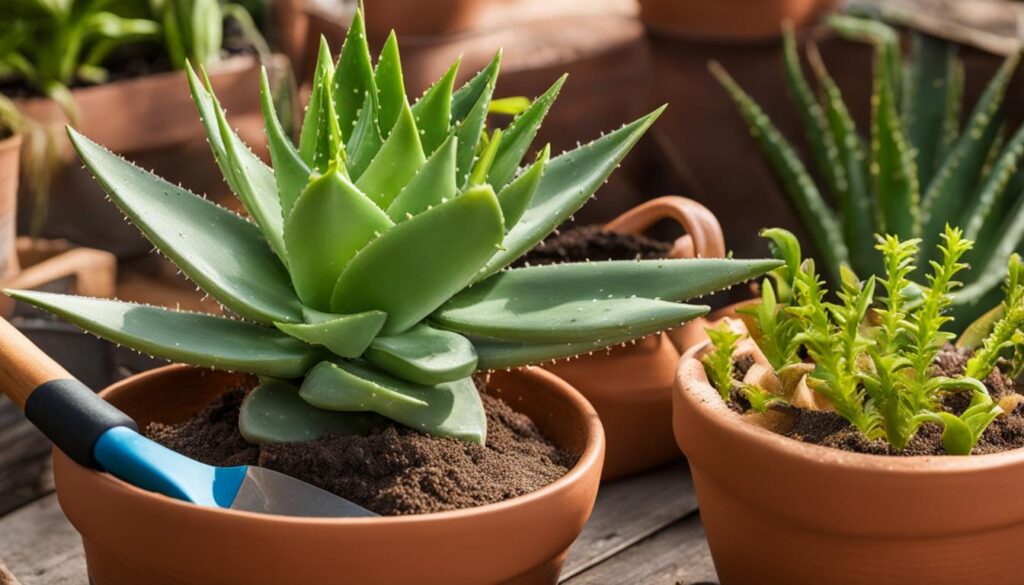
| Conditions | Requirements |
|---|---|
| Sunlight | Bright, indirect light |
| Soil | Well-drained, sandy or loamy soil |
| Watering | Sparingly, only during dry periods |
| Temperature | Protection from extreme cold |
How to Grow Aloe Vera from Leaf Cuttings
If you’re looking to expand your collection of aloe vera plants or share them with friends, growing aloe vera from leaf cuttings can be an interesting method to try. While it may not always guarantee success, it can be a fun experiment for plant enthusiasts. Here’s a step-by-step guide on how to grow aloe vera from leaf cuttings.
Materials:
- Healthy mature aloe vera leaf
- Clean, sharp knife or scissors
- Well-draining potting mix
- Small pot
- Misting bottle (optional)
Procedure:
- Select a mature leaf from a healthy aloe vera plant. Choose a leaf that is plump and without any signs of damage or disease.
- Using a clean, sharp knife or scissors, cut the leaf as close to the stem as possible. It’s important to leave a clean cut to ensure successful propagation.
- Allow the cut end of the leaf to dry out and form a callus. This can take anywhere from a few days to a week.
- Prepare a small pot with a well-draining potting mix. Make a small hole in the soil using your finger or a pencil.
- Place the cut end of the leaf into the hole in the soil, making sure it is in contact with the soil. Gently press the soil around the leaf to secure it in place.
- Water the soil lightly, being careful not to overwater. The soil should be kept slightly moist but not saturated.
- Place the pot in a warm and bright location, but avoid direct sunlight. Aloe vera prefers indirect light during the propagation stage.
- Monitor the soil moisture and mist the leaf occasionally if the environment is dry. Be patient, as it can take several weeks or even months for new growth to emerge.
- Once new plantlets have formed and are several inches tall, you can gently separate them from the original leaf and transplant them into individual pots.
By following these steps and providing the right care, you may be able to successfully grow aloe vera plants from leaf cuttings. Remember to be patient and adjust the watering and lighting as needed. While not every leaf cutting will result in a new plant, it can be a rewarding process when you see new growth emerge.
How to Care for Aloe Vera
Proper care is essential for the health and well-being of your aloe vera plants. Here are some key tips for maintaining your plants:
Watering
Aloe vera plants should be watered deeply but infrequently. Allow the soil to dry out between waterings to prevent overwatering and root rot. It’s best to water your plants about once every two weeks, depending on the climate and humidity levels.
Sunlight
Aloe vera plants thrive in bright, indirect sunlight. Place them near a window or in a location where they can receive several hours of sunlight each day. However, be cautious of exposing them to direct sunlight for extended periods, as it can cause sunburn and damage the plant.
Soil and Fertilization
Use a well-draining soil mix for your aloe vera plants, such as a mix of sand and potting soil or a specialized succulent mix. This will prevent excess moisture and promote healthy root growth. Fertilize your plants once a year in the spring with a phosphorus-containing fertilizer to support their overall growth and health.
Pruning and Maintenance
Regularly prune any brown or withered leaves from your aloe vera plants to maintain their appearance and overall health. Remove the flowers after they bloom to redirect the plant’s energy towards foliage growth. Additionally, inspect your plants for any signs of pests or diseases and take appropriate measures to address them promptly.
By following these care tips, you can ensure that your aloe vera plants thrive and continue to provide you with their numerous benefits.
| Care Tips | Details |
|---|---|
| Watering | Deep, infrequent watering. Allow soil to dry out between waterings. |
| Sunlight | Bright, indirect sunlight. Avoid prolonged exposure to direct sunlight. |
| Soil and Fertilization | Well-draining soil mix. Fertilize once a year in spring with phosphorus-containing fertilizer. |
| Pruning and Maintenance | Regularly prune brown or withered leaves. Remove flowers after blooming. Inspect for pests and diseases. |
How to Repot Aloe Vera
Repotting your aloe vera plants is an essential part of their care and maintenance. It allows the plants to access fresh nutrients and provides them with more space to grow. Here’s a step-by-step guide on how to repot your aloe vera:
Gather the necessary supplies:
- A slightly larger pot with good drainage
- Well-draining potting mix
- Watering can or spray bottle
- Gardening gloves
Prepare the plant for repotting:
- Water the plant 24 hours before repotting to make it easier to remove from the pot.
- Gently remove the plant from its current pot, taking care not to damage the roots.
Repot the aloe vera:
- Place the plant in the new pot and fill it with a well-draining potting mix, leaving room for the roots to breathe.
- Press the soil gently around the plant to secure it in place.
- Water the plant immediately after repotting to help settle the soil.
After repotting, monitor the growth and health of your aloe vera plant. Keep it in a spot with adequate sunlight and water it appropriately. Remember to repot your aloe vera plants every 1-2 years or when you notice that they have outgrown their current pots. Following these steps will ensure that your aloe vera continues to thrive and flourish.
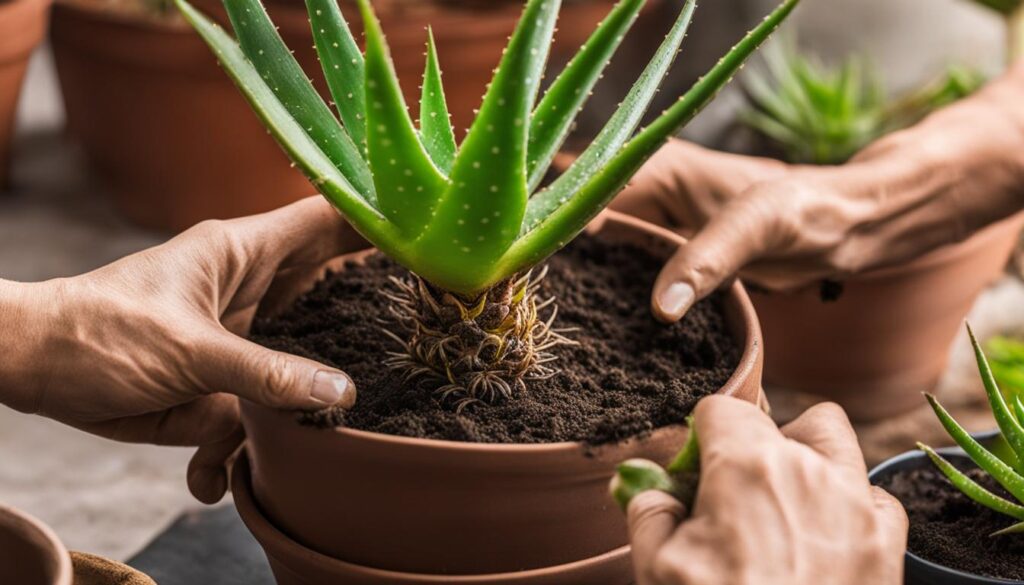
How to Harvest Aloe Vera
Harvesting aloe vera is a simple process that allows you to harness the plant’s beneficial gel for various purposes. To begin, select a mature leaf from your aloe vera plant and cut it as close to the stem as possible. It’s important to choose a leaf that is at least eight inches long to ensure a sufficient amount of gel. When cutting the leaf, use a clean, sharp knife or scissors to avoid damaging the plant.
Once you have harvested the aloe vera leaf, you can extract the gel by carefully slicing it lengthwise. Use a spoon to scoop out the gel from the leaf and transfer it to a clean container. The gel can be used topically to soothe sunburns, minor cuts, and skin irritations. It’s important to note that aloe vera gel should not be ingested, as it can have laxative effects and may be toxic in larger quantities.
In addition to using the gel topically, some people also opt to make aloe vera juice for various purposes. To do this, blend the gel with water or a citrus juice of your choice. Strain the mixture to remove any pulp or debris, and store the juice in the refrigerator for up to a week. Aloe vera juice can be used as a hair conditioner, makeup remover, or even as a natural brow gel.
Common Issues with Aloe Vera Plants
While aloe vera plants are generally resilient and low-maintenance, they can still encounter some common issues that require attention and care. Understanding and addressing these problems promptly can help ensure the overall health and vitality of your aloe vera plants.
Potential Issues
One common issue with aloe vera plants is overwatering. These plants are adapted to dry conditions and prefer well-draining soil. Overwatering can lead to root rot and other problems, causing the leaves to turn yellow or wilt. It’s important to establish a watering routine that allows the soil to dry out between waterings.
Inadequate sunlight is another issue that can affect aloe vera plants. These plants thrive in bright, indirect sunlight. Insufficient light can result in leggy growth and a loss of vibrant green color in the leaves. If you notice your plant isn’t receiving enough sunlight, consider moving it to a brighter location.
Pests can also be a challenge for aloe vera plants. Common pests that may infest these plants include mealybugs, spider mites, and snout beetles. Regularly inspect your plants for any signs of pest infestation, such as webbing or small insects. If pests are present, take appropriate measures to control and eliminate them.
Common Aloe Vera Plant Problems
Some specific problems that can arise with aloe vera plants include:
- Root rot: Overwatering can cause root rot, leading to weak and unhealthy plants.
- Yellowing leaves: Insufficient sunlight or overwatering can cause the leaves to turn yellow.
- Leggy growth: Aloe vera plants that don’t receive enough light may stretch or become leggy.
- Pest infestation: Mealybugs, spider mites, and snout beetles are common pests that can affect aloe vera plants.
- Diseases: Aloe rust, sooty mold, and basal stem rot are diseases that can impact the health of these plants.
By addressing these common issues and providing your aloe vera plants with the care they need, you can help ensure their long-term health and enjoyment. Regular monitoring, proper watering, sufficient sunlight, and prompt action against pests or diseases are all important aspects of maintaining vibrant and thriving aloe vera plants.
Conclusion and Our Recommendation
Growing and caring for aloe vera plants can be a rewarding and fulfilling experience. By following the guidelines provided in this guide, you can ensure the optimal growth and health of your aloe vera plants. Remember to provide them with the right conditions, including proper watering, sunlight, and well-drained soil.
Regular pruning and repotting when necessary are essential for maintaining the overall health and appearance of your aloe vera plants. Additionally, knowing how to harvest aloe vera properly allows you to utilize its clear gel for various topical purposes.
Overall, aloe vera plants are relatively low-maintenance and can thrive both indoors and outdoors with minimal effort. With a little care and attention, these versatile plants can provide you with numerous benefits. So go ahead, start growing and caring for your aloe vera plants, and enjoy the beauty and benefits they bring to your home or garden!
FAQ
What are the different types of aloe plants?
The different types of aloe plants include Aloe Vera, Aloe Arborescens, Aloe Aristata, Aloe Polyphylla, Aloe Ferox, Aloe Variegata, and Aloe Mitriformis.
Can I grow aloe vera plants indoors?
Yes, aloe vera plants can be grown indoors. Provide them with bright, indirect sunlight and water them deeply about once every two weeks.
Can I grow aloe vera plants outdoors?
Yes, if you live in a warm climate (Zone 10 or higher), you can grow aloe vera plants outdoors. They require minimal watering and can tolerate a wide range of temperatures.
How can I grow aloe vera from leaf cuttings?
To grow aloe vera from leaf cuttings, select a mature leaf, allow the cut end to callous, and plant it in well-draining potting mix. Water sparingly until roots develop.
How should I care for my aloe vera plants?
Proper care for aloe vera plants includes watering deeply but infrequently, providing them with bright, indirect sunlight, and fertilizing once a year in the spring.
When should I repot my aloe vera plants?
Repot your aloe vera plants when they outgrow their current pots. Use a container with good drainage and slightly larger than the current pot.
How do I harvest aloe vera?
To harvest aloe vera, select a mature leaf and cut it as close to the stem as possible. Use the gel topically for various purposes, such as treating sunburn and minor cuts.
What are some common issues with aloe vera plants?
Common issues with aloe vera plants include overwatering, insufficient light, pests like mealybugs and spider mites, and diseases like aloe rust and basal stem rot.

